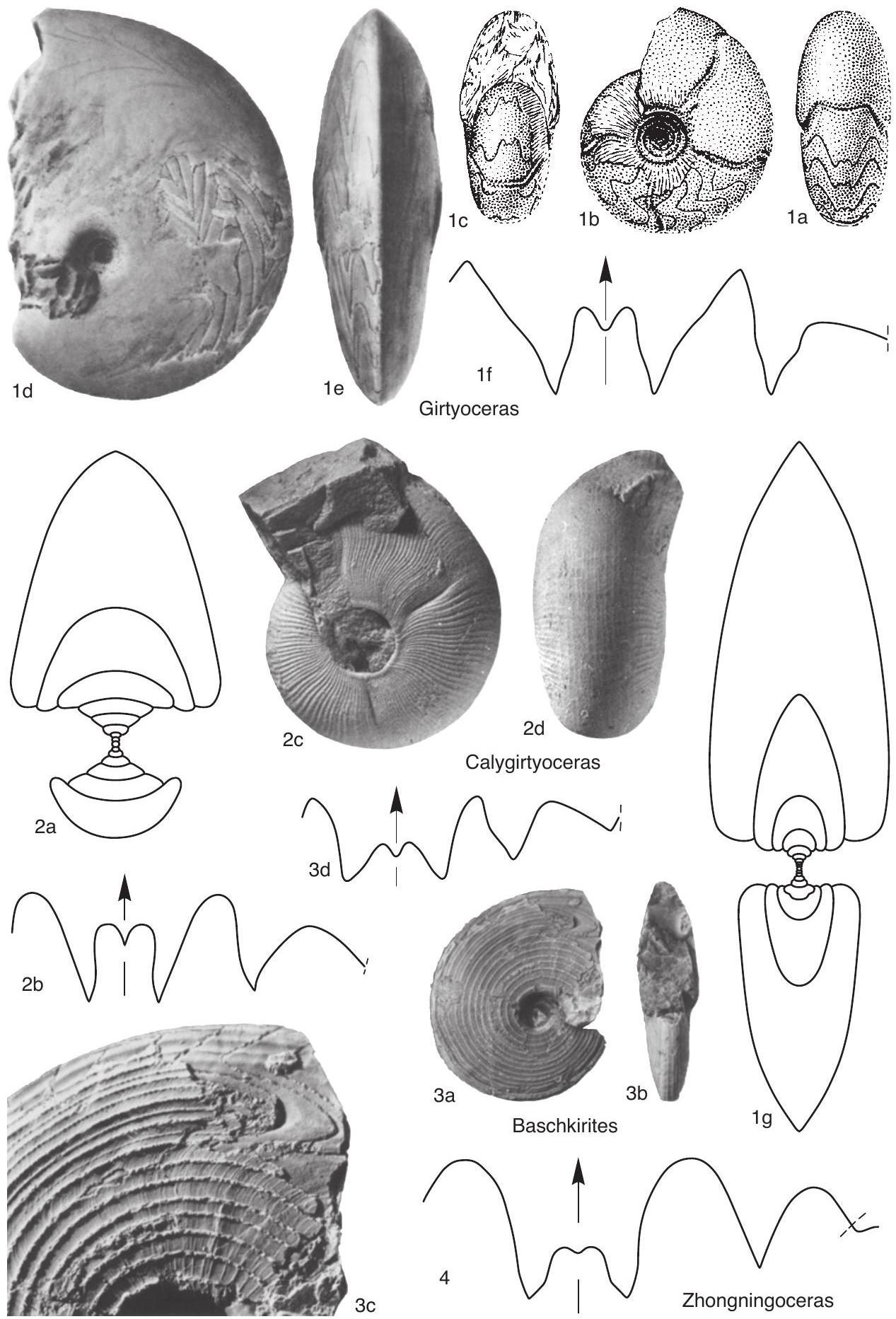Welcome to the Treatise on Invertebrate Paleontology!
Please enter a genera name to retrieve more information.

Girtyoceras
Classification
Phylum:
Mollusca
Class:
Cephalopoda
Subclass:
Ammonoidea
Order:
Goniatitida
Suborder:
Goniatitina
Superfamily:
Dimorphoceratoidea
Family:
Girtyoceratidae
Subfamily:
Girtyoceratinae
Formal Genus Name and Reference:
Girtyoceras WEDEKIND, 1918, p. 140
Type Species:
Adelphoceras meslerianum GIRTY, 1909, p. 66, OD
Images
(Click to enlarge in a new window)
Fig. 26, 1a-g. *G. meslerianum (Girty), a-c, Chesterian, Oklahoma, USA, X 2.5, d-e, Chesterian, Texas, USA, X 0.8 (Miller, Furnish, & Schindewolf, 1957), f, suture, Caney Formation, Delaware Creek Member, Oklahoma, SUI 10932, diameter at 81 mm, X 0.8, g, cross section, Caney Formation, Delaware Creek Member, Wapanucka, Oklahoma, SUI 10932, X 1 (McCaleb, Quinn, & Furnish, 1964).
Synonyms
Sagittoceras; Dryochoceras; Cowdaleoceras; Jeminayceras
Geographic Distribution
Great Britain, Belgium, France, Germany, Czech Republic, Poland, Russia (Novaia Zemlia, North Urals), Spain, Portugal, Algeria, Morocco, Ukraine, South Urals, Kazakhstan (Karaganda), China (Yunnan, Ningxia, Xinjiang), Australia (New South Wales), USA (Alaska, Arkansas, Georgia, Montana, Nevada, Oklahoma, Texas, Utah)
Age Range
Beginning Stage in Treatise Usage:
Mississippian (upper Visean-lower Serpukhovian)
Beginning International Stage:
Visean
Fraction Up In Beginning Stage:
66
Beginning Date:
335.91
Ending Stage in Treatise Usage:
Mississippian (upper Visean-lower Serpukhovian)
Ending International Stage:
Serpukhovian
Fraction Up In Ending Stage:
50
Ending Date:
326.87
Description
Conch form in young stages with wide umbilicus and low whorl section, later with small umbilicus, tendency to form an acute venter in relatively young stages, Shell surface in young stages commonly smooth, later temporarily ribs or umbilical nodes, constrictions may be present, No ventrolateral grooves, Ventral lobe wide, with rounded or straight diverging sides, median saddle reaching about half height of ventral lobe, First lateral saddle narrowly rounded, sometimes spatulate, Adventitious lobe moderately deep, pointed, and relatively wide
References
Museum or Author Information
Classification
Phylum:
Mollusca
Class:
Cephalopoda
Subclass:
Ammonoidea
Order:
Goniatitida
Suborder:
Goniatitina
Superfamily:
Dimorphoceratoidea
Family:
Girtyoceratidae
Subfamily:
Girtyoceratinae
Formal Genus Name and Reference:
Girtyoceras WEDEKIND, 1918, p. 140
Type Species:
Adelphoceras meslerianum GIRTY, 1909, p. 66, OD
Images
(Click to enlarge in a new window)
Fig. 26, 1a-g. *G. meslerianum (Girty), a-c, Chesterian, Oklahoma, USA, X 2.5, d-e, Chesterian, Texas, USA, X 0.8 (Miller, Furnish, & Schindewolf, 1957), f, suture, Caney Formation, Delaware Creek Member, Oklahoma, SUI 10932, diameter at 81 mm, X 0.8, g, cross section, Caney Formation, Delaware Creek Member, Wapanucka, Oklahoma, SUI 10932, X 1 (McCaleb, Quinn, & Furnish, 1964).
Synonyms
Sagittoceras; Dryochoceras; Cowdaleoceras; Jeminayceras
Geographic Distribution
Great Britain, Belgium, France, Germany, Czech Republic, Poland, Russia (Novaia Zemlia, North Urals), Spain, Portugal, Algeria, Morocco, Ukraine, South Urals, Kazakhstan (Karaganda), China (Yunnan, Ningxia, Xinjiang), Australia (New South Wales), USA (Alaska, Arkansas, Georgia, Montana, Nevada, Oklahoma, Texas, Utah)
Age Range
Beginning Stage in Treatise Usage:
Mississippian (upper Visean-lower Serpukhovian)
Beginning International Stage:
Visean
Fraction Up In Beginning Stage:
66
Beginning Date:
335.91
Ending Stage in Treatise Usage:
Mississippian (upper Visean-lower Serpukhovian)
Ending International Stage:
Serpukhovian
Fraction Up In Ending Stage:
50
Ending Date:
326.87
Description
Conch form in young stages with wide umbilicus and low whorl section, later with small umbilicus, tendency to form an acute venter in relatively young stages, Shell surface in young stages commonly smooth, later temporarily ribs or umbilical nodes, constrictions may be present, No ventrolateral grooves, Ventral lobe wide, with rounded or straight diverging sides, median saddle reaching about half height of ventral lobe, First lateral saddle narrowly rounded, sometimes spatulate, Adventitious lobe moderately deep, pointed, and relatively wide
